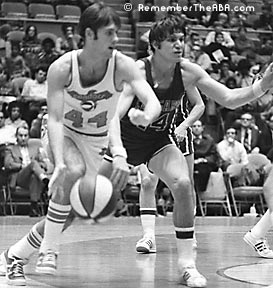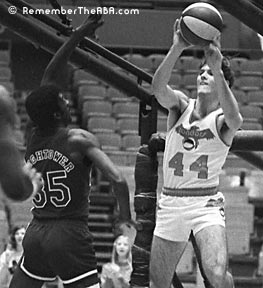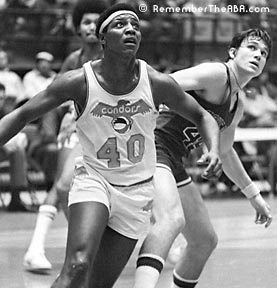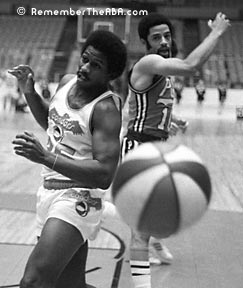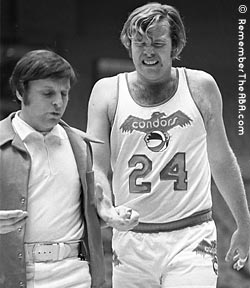Back to "Remember the ABA" Main Page
Did you see a Pittsburgh Condors game? Or, did you have a favorite Condors player? Contribute to this web page by describing your favorite Condors memories.
The ABA had a strange history in Pittsburgh.
The Pittsburgh Pipers were part of the ABA's 1967-68 inaugural season. Led by Hall of Famer Connie Hawkins, the Pipers were a strong team - they earned some hardcore fans and positive local attention as they fought for and won the first ABA Championship. But the next season, team owner Gabe Rubin inexplicably abandoned Pittsburgh and moved his team to Minneapolis, Minnesota (where another inaugural ABA team, the Minnesota Muskies, had already failed due to lack of fan support). The Pipers' move to Minnesota was a disaster in all respects. The fans left behind in Pittsburgh were angry and upset. And, Minneapolis residents cared about the Minnesota Pipers even less than they cared about the Minnesota Muskies - attendance was almost non-existent during the 1968-69 season, and the franchise lost huge amounts of money.
After spending only one season in Minnesota, team owner Gabe Rubin made another inexplicable decision - he moved the team BACK to Pittsburgh. Needless to say, Pittsburgh residents were more than a little annoyed with the situation - many of the team's former fans viewed the ABA as a "mickey mouse" operation, and wanted nothing more to do with the league. The Pipers received terrible press upon their return to the Steel City. Very few season tickets were sold. The Civic Arena was largely empty during the 1969-70 season - not only did the fans hold a grudge against the team, but Hawkins had departed to the NBA. That left the Pipers with little talent. Nobody in Pittsburgh seemed to care about ABA basketball, as the Pipers struggled to a dismal 29-win 5th place finish.
Given this situation, it seemed logical that the Pipers should either fold or move to a new city for the 1970-71 season. But ABA business decisions rarely made sense - especially those made in Pittsburgh. In the spring of 1970, Rubin sold the team to a new corporate owner, Haven Industries, Inc. - the owner of the "Jack Frost" brand of sugar products. While Haven Industries was headquartered in New York City, it still decided to keep the team in Pittsburgh. For some unknown reason, the company believed that Pittsburgh still could support ABA basketball.
Haven Industries immediately got rid of the Pipers nickname. Understandably, it wanted to promote a new image and a new attitude for the team. The team's new front office held a "name the team" contest, open to the general public. The name "Pioneers" was selected as the winning entry, and the man who submitted the name won a $500 cash prize. At this point, things really started to get strange - even by ABA standards. A local NAIA school, Point Park College, was already using the "Pioneers" nickname. In fact, the school's offices were only five blocks from the team's offices. The school threatened immediate legal action against the ABA club if the "Pioneers" name was not dropped. At the same time, a female contestant sued the team, claiming that the winning "Pioneers" entry did not stay within the designated 25-word contest limit. Faced with an alarming amount of litigation over a mere nickname, the team avoided further chaos by dumping the "Pioneers" name and picking its own "safer" alternative - the "Condors." Why "Pittsburgh Condors"? No explanation was ever provided, although the "endangered" status of real condors seemed equally applicable to this franchise.
With the pesky nickname issue finally resolved, the team received a badly-needed infusion of cash from Haven Industries. It seemed that the franchise would finally be able to focus on winning back some Steel City fans.
But, signs of trouble were still everywhere for the Condors.
Their prize rookie, Mike Maloy, arrived at training camp 50 pounds over his college playing weight. One club official joked that Maloy showed up so fat that "we put him out in the middle of the court and ran the team around him to build up our wind." New coach Jack McMahon promptly shipped Maloy to the Virginia Squires and got virtually nothing in return.
To no one's surprise, the Condors got off to a poor start - through November 9, 1970, their record stood at 4-8. To "jumpstart" local interest, new GM Marty Blake decided to give away all available tickets to Pittsburgh's November 17, 1970 home game against the Floridians. With every seat in the 13,000 seat Civic Arena given away for free (!), only 8,074 fans actually showed up to watch the game. More than 3,000 ticketholders didn't even bother to come. Of course, the Condors lost the game 122-116.
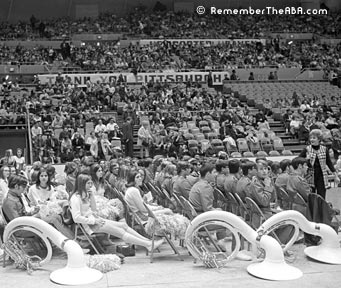 |
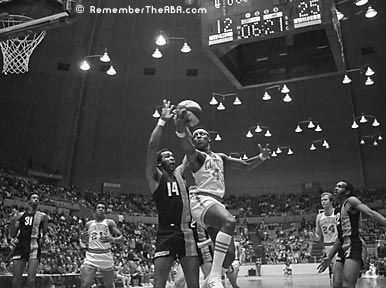 |
Here are some rare photos from the "free ticket night" held by the Pittsburgh Condors on November 17, 1970. The images are jarring - if only for the fact that most Condors action photos from the Civic Arena show a virtual sea of empty seats. In contrast, these shots show a mostly-filled Arena.
The promotion drew 8,074 fans. It was the highest attendance the Condors would ever have during their brief and tumultuous 2-year existence. As can be seen in the photo above, left, the team tried to create an "event" with a band and signs all over the Arena ("Thank You Pittsburgh," etc.).
These fans might have come back for more Condors games, but the team's performance was embarrassing. In the photo above right, John Brisker floats to the hoop against Trooper Washington of The Floridians. The scoreboard in the background indicates that only halfway through through the 1st quarter, the Condors were already losing by a score of 25-12. |
Haven Industries trustee Donald J. Bezahler condemned the free ticket night as "an act of desperation" and relieved Blake of his GM position a month and a half later when Pittsburgh's record slipped to 17-27. "I'm tired of the promotional gimmicks" Bezahler stated. He wasn't satisfied with the team's performance on the floor either. "We've put more than a million dollars into this club, and we have very little show for it. I have to think if we had something to offer we could get four or five thousand people to come out to see it."
The primary reason for the team's poor record in 1970-71? The Condors were vulnerable to the fast break, and every other team in the ABA knew it. The Condors lacked overall quickness, and were prone to falling into a static offense. Pittsburgh played in a lot of entertaining, high scoring games, but usually came out on the losing end.
Talented forward/guard John
Brisker took advantage of the frequent shootouts to boost his scoring average to an impressive 29.3 points per game. Brisker was not a timid shooter. He often heaved up 25-30 shots per game. At one point during the season, Brisker scored 53 points against the Indiana Pacers, and 50 points against the Texas Chaparrals--on consecutive nights (November 12 & 13, 1970). He ended up being the ABA's third leading scorer in 1970-71. Brisker's offensive skills and gaudy scoring average attracted the notice of the NBA's Philadelphia 76ers and Atlanta Hawks. Each of these NBA clubs tried to tempt Brisker into jumping leagues. However, Brisker seemed happy in Pittsburgh and signed a contract extension with the Condors.
Brisker had a feathery jump shot and used finesse to get many of his points. But he also had a nasty court personality, and loved to fight. During the 1970-71 season, Brisker was involved in bloody confrontations with Joe Caldwell of Carolina, Wendell Ladner of Memphis, and Ron Boone of Texas. Around the league, Brisker became known as the "heavyweight champion of the ABA." Appropriately, the Condors' press guide pictured Brisker as an ill-tempered hombre - ready to draw a pair of six-shooters.
Many of Brisker's teammates were wary of practicing hard against him, as he was perfectly happy to fight them at the slightest provocation. Condors guard Walt Szczerbiak recalls: "The only problem I had in Pittsburgh was I had to guard John Brisker in practice every day. And he wasn't a very nice person the day after a game, in practice. And he didn't want some rookie who was trying to do his job competing and trying to win some playing time. Even getting within ten feet of him."
Another memorable Condor was Stew
Johnson. Johnson, like Brisker, was also "offensive-minded." But, he was not as consistent as Brisker. On March 6, 1971, Johnson surprised the entire ABA by scoring 62 points again the Floridians. That was an ABA record at the time - the previous record of 59 points belonged to Spencer Haywood of the Denver Rockets. To beat Haywood, Johnson went 25 of 44 from the field, including one three-pointer. He also hit 11 straight at the foul line. The night before, he had poured in a scintillating 3 points against the Virginia Squires, going 0 for 7 from the floor. One ABA executive told writer Jim O'Brien: "If I had made a list of 50 ABA guys who might hit 60 points, Stew Johnson would not have been on it." The Condors' other star was hard-working forward/guard George Thompson, who averaged 27.0 ppg in 1971-72.
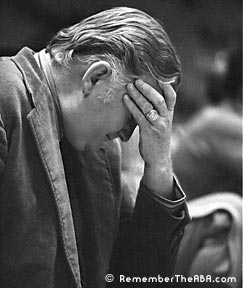
|
While the 70-71 Condors were terrible, they did have some entertaining players. A few of them are pictured above. Above left, team scoring leader John Brisker (#40) drives past Ron Franz of The Floridians. This was Brisker's second year in the league. He increased his scoring average to an impressive 29.3 points per game, an increase of 8 points over his rookie average. Although the Condors' run-and-gun style probably inflated this figure, it placed him second in the league in scoring, behind only Dan Issel of the Kentucky Colonels.
Above middle, Stew Johnson (#13) shoots over Manny Leaks of the New York Nets. Johnson ran hot and cold during his time with the Condors. One game he could be ice cold, scoring only a few points. The next game he could erupt in a scoring binge of historic proportions. That is exactly what happened on the nights of March 5 and 6, 1971, when Johnson followed up a 3 point performance against the Virginia Squires with an incredible 62 point performance against The Floridians.
Above right, center Mike Lewis (#24) gets one away over Billy Paultz of the Nets. Lewis fought for every loose ball and rebound, and was a steady, unappreciated presence in the middle for the hapless Condors. He averaged 14.6 rebounds, third best in the entire ABA.
At left is exasperated coach Jack MacMahon. MacMahon suffered through countless evenings of helter-skelter offense and "matador" defense from his Condors. With the team's constant difficulties on the court, plus impatient management, MacMahon had one of the toughest jobs in the ABA. |
Mark Binstein took over as GM after Blake's departure from the team. Binstein acquired Rich Johnson and Arvesta Kelly for the team's "stretch drive." He
also devoted a lot
of time trying to lure Connie Hawkins back
to the Condors from the NBA Phoenix Suns. The latter half of the
1970-71 season was filled with rumors that Hawkins would return to the
franchise to finish his career in his home town. The "Return of Hawkins" never happened - Binstein habitually answered "no comment" to
just about every press inquiry on the subject. The Condors limped
home with a 36-48 record, and ended up with the worst
home attendance in the league. The Condors "officially" averaged
2,806 fans per game in 1970-71. Observers close to the team noted that this
figure was obviously padded and that the true figure was probably about
1,100 per game.
With all of the constant problems, it seemed highly unlikely that the team could last another year - let alone in Pittsburgh. But that is exactly what happened. A deal to sell the team to Washington D.C. interests fell through a month before the season started. After that, Haven Industries gambled and decided to give the Condors one more try in Pittsburgh. It seemed that Haven Industries wanted to keep the team afloat at any cost, so that the Condors could cash in on a possible ABA/NBA merger. Haven Industries representative Bezahler stated: "We want to keep this team in Pittsburgh. An awful lot of money has been poured into the franchise, and we feel it's on the verge of a breakthrough."
Of course, gambling big money on a distant and unlikely payoff is never a good idea if most everyone in your geographic market dislikes your current product. This was the basic problem facing the 1971-72 Condors. To its credit, the team's front office (and in particular publicity director Fred Cranwell) tried very hard to fix the image of the team. The Condors:
 |
- Retired their 1970-71 cartoon bird logo in favor of a more militaristic and "intimidating" bird logo.
|
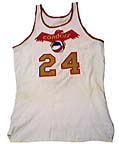 |
- Completely redesigned their uniforms to reflect the new logo. The new unis were sharp. They're one of the most popular "throwback" jerseys today - just check eBay.
|
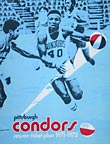 |
- Mailed out an attractive and flashy season ticket brochure, known among ABA collectors to be one of the best ticket brochures ever produced by any ABA team. The brochure had John
Brisker on the cover. It touted an exclusive "Igloo Club" for season ticket holders - club membership gave special parking privileges, autograph sessions with Condors coaches and players, and access to a special hospitality room at the Civic Center before and after home games.
|
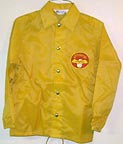 |
- Ramped up the production of team merchandise. There were Condors wristwatches, Condors windbreakers (left), Condors team photo sets, Condors ashtrays, Condors t-shirts, Condors stocking caps, and Condors wristbands. Some ABA beat writers noted that Pittsburgh had the best merchandising program of any ABA team and offered items not on display anywhere else.
|
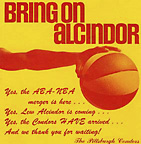 |
- Scheduled an exhibition game at the Civic Center against the NBA Champion Milwaukee Bucks and Kareem Abdul-Jabbar (for various reasons, the game itself did not live up to expectations - see Fred Cranwell's memory found below).
|
Unfortunately, none of these steps really improved the situation.
The Condors had signed 6' 8" All-American Howard Porter to a contract in December of 1970. However, Porter observed the franchise during the spring of 1971, and decided he didn't like the Condors as much as he thought earlier. He signed another contract with the NBA's Chicago Bulls. A bitter legal battle ensued between the Condors and the Bulls. Porter ended up as a Bull for the 1971-72 season (as part of the unique settlement, the Condors received the gate receipts from an exhibition game against the Bulls, plus journeyman forward Paul Ruffner).
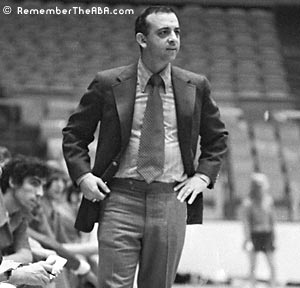 After a 4-6 regular season start (not bad by Condors standards!), GM Binstein suddenly canned coach Jack McMahon. Then, in a move that further surprised many ABA observers, Binstein named himself as McMahon's replacement. Binstein had no previous pro coaching experience, although he had played some college basketball at West Point.
After a 4-6 regular season start (not bad by Condors standards!), GM Binstein suddenly canned coach Jack McMahon. Then, in a move that further surprised many ABA observers, Binstein named himself as McMahon's replacement. Binstein had no previous pro coaching experience, although he had played some college basketball at West Point.
Serving as both GM and coach (photo at left), Binstein shook things up right away. He traded offensive gunner Stew Johnson to the Carolina Cougars for...well...another offensive gunner, Bob Verga. On obtaining Verga, Binstein made this strange comment: "I have three players who might kill him if he doesn't give up the ball. It is my hope that a young man with all his talent is aware that this is his sixth team."
Binstein made further strange moves. The Condors had a promising young guard for the 1971-72 season - Jimmy O'Brien out of Boston College. Under McMahon, O'Brien enjoyed significant playing time. But under Binstein, O'Brien rode the pine. Binstein finally traded O'Brien to the Kentucky Colonels for forward Goose Ligon. While the Condors needed Ligon's rebounding and hustle, they missed O'Brien's playmaking and unselfish game. After the trade, O'Brien noted that: "The deal was a complete surprise to me. When Jack McMahon was coach, I wasn't starting, but I did average about 24 minutes of playing time. I was more or less running the entire offense, and I had some very good games. Especially early in the season. When McMahon was fired and Binstein took over, I was reduced to two minutes of playing time. What really bothered me was the fact that Binstein never offered any kind of an explanation. The offense was changed completely, and it was obvious that there were no plans for me." O'Brien also offered this stark comparison of the Colonels and the Condors: "Kentucky is a great franchise and one that is not going to fold. As you know, Pittsburgh is in trouble at the gate and there have been rumors of a sale and also of the team just folding."
Under Binstein's first nine games as coach, false optimism abounded as the Condors went 5-4. The five wins included a road victory over the defending champion Utah Stars, and a home triumph against the eventual 1971-72 champion Indiana Pacers. The Condors even attracted an impressive 4,502 fans to the Civic Center for a game against Rick Barry and the New York Nets. But, as often was the case in Pittsburgh, things "went south" pretty quickly. The Condors went 16-49 the rest of the way.
Jimmy O'Brien (above, # 44) was a Pittsburgh Condor for just the first few weeks of the 1971-72 season. Coach Jack McMahon played him a lot, saying: "He's going to be a good one. He does everything smoothly. The shooters on this club are going to buy all of his cokes. He'll be that valuable to them. He'll get everybody more points."
After only 18 games, McMahon was already gone (fired by GM Mark Binstein), and O'Brien was traded to the Kentucky Colonels for Goose Ligon. The Condors missed his unselfish play. O'Brien, on the other hand, happy to go to Kentucky - in contrast to the Condors, Kentucky had good owners, money and fan support.
|
Frustration set in soon enough. In early December John
Brisker was ejected from a home game against the Denver Rockets only 2 minutes into the game. He had brutally elbowed Art Becker of the Rockets. After receiving his ejection notice from referee Earl Strom, Brisker came back onto the floor and hit Becker again. Both benches cleared, and Brisker was held back by his teammates. But as Becker went to the free throw line, Brisker broke free and hit the Denver forward yet again. Finally, the police rushed onto the court and pulled Brisker off the Civic Arena court. Denver's coach, Alex Hannum, had this to say about the incident: "Utterly uncalled for. It was a cheap shot, the worst I've seen in all my years in basketball."
Aside from being kicked out of games for fighting, Brisker also missed 15 of the team's first 55 games due to a variety of ailments, including groin pulls, hamstring pulls, a strained Achilles tendon, bruised ribs, a chipped elbow bone, and severe back pain. On January 25, 1972, Brisker felt good, returned to the starting lineup, and scored 36 points to help the Condors upset the New York Nets in overtime at the Civic Arena. He then went back to the bench with more injuries. Upon returning a week later, he scored 52 and 40 points in consecutive games at Greensboro vs. the Cougars (Feb. 5) and Miami vs. the Floridians (Feb. 6). But in the next game, at Indianapolis vs. the Pacers, he injured himself yet again. At the time he said "I'm having a better year than last all around - scoring, assists, rebounds - but I'd sure like to play more. I've never had a season like this. I've just been riddled with injuries." When he did play, Brisker was the heart of the team, 29.2 ppg, 86.3% from the line, and 32.2% from three-point land.
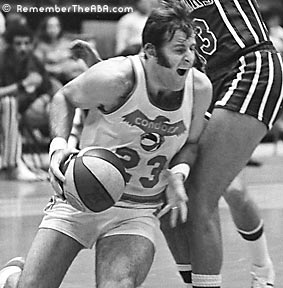
|
The 1971-72 Condors featured classy new uniforms. But the cast of characters largely remained the same.
In his last year in the ABA, John Brisker (#40, above left) was simply a force. He pushed aside most opponents to average 29.2 ppg. Where he couldn't make any headway against a defender, he would start a fistfight. Brisker lead the league in scuffles, fights, haymakers and ejections.
With Brisker hurt for several weeks during the season, George Thompson (#25, above middle) took up the slack. He averaged 27.0 ppg, including a career-best 31% from the three-point line.
Above right, Condors trainer Ray Melchiorre tends to a hand-injury suffered by center Mike Lewis (#24). Lewis was willing to play with pain. Despite a number of minor injuries, he played in 82 of the team's 84 games (best among all Condors).
The Condors also had burly forward Harley "Skeeter" Swift (left, #23). Out of East Tennessee State University, Swift had long Elvis-style sideburns and was a fan favorite. Out of deference to his popularity, team management even allowed him to place his nickname on the back of his jersey. Swift was another gunner on a team of gunners. He was the fourth-leading scorer on the team (behind Brisker, Thompson, and Bob Verga). |
As the losses mounted for the Condors, attendance plummeted to less than 1,000 fans per game. Rumors abounded that the Condors would soon move to New Haven, Connecticut to finish out the season. Players were actually told to wind up their personal business in the Steel City. The very last Condors home game at the Civic Arena was supposed to be against Kentucky on December 21. New York Nets owner Roy Boe offered his own wide-ranging thoughts on the Condors' increasingly dire situation:
Something has to be done . . . They are in trouble. Right now I don't know what is going to happen. New Haven is within the territorial rights of both the Nets and the New York Knicks. Hartford might be the solution, or some type of combination of Hartford and Springfield, Massachusetts. Maybe the Condors will even fold. I know their front office is convinced that the team can't make it at the Civic Arena any longer. The Condors would need a majority vote from ABA owners to move any place, and if the city they wanted to move to is within my territorial rights, then I would be able to veto the change. Don't forget the Knicks, either. We already have an agreement with the NBA to go together to Congress for the merger. We wouldn't want the Condors to do anything that would interfere with that.
December 21 came and passed, and the Condors remained in Pittsburgh. Sounding like a broken record, team President Bezahler finally issued a statement: "There is no sense to keep pouring good money into the franchise while it is in Pittsburgh. There is too much talent on our club for it not to be appreciated by the fans. We are not going to move this season since it is too late. But we are looking around for next year. New Haven-Hartford-Springfield is just one possible area for us."
The Condors never "moved" to another city during the 1971-72 season. But, in the spring of 1972, they took unique and unprecedented steps to abandon Pittsburgh. In February, they shifted several home games from the Civic Arena to other locations across Pennsylvania. Pittsburgh's February 9 home game vs. the Utah Stars was shifted to Uniontown, over 40 miles from Pittsburgh. That game was played in at Uniontown High School and drew 1,750 fans. The March 14 home game vs. the Virginia Squires was shifted to Connellsville, around 15 miles away from Pittsburgh. That game only drew only 500 fans.
But, to improve non-existent gate receipts in the Pittsburgh area, why not shift home games to other far-flung and remote locations - maybe even other states? Amazingly, that is what the Condors decided to do. Essentially, they became the "United States Condors." The March 24 home game against the Kentucky Colonels was moved to - of all places - Birmingham, Alabama. 3,000 half-interested fans showed up at Birmingham's Boutwell Auditorium to see the Condors lose to the Colonels, 134-107. The March 28 home game, also against Kentucky, was shifted to Tucson, Arizona. Yes, Tucson, Arizona. 5,000 fans showed up to see the Condors lose to the Colonels, 136-134. It was the very last Condors "home" game ever.
After the "U.S. Condors" staggered to the end of the 1971-72 season with a 25-59 record, the league had finally seen enough. The ABA finally folded the franchise and held a special dispersal draft for those Condors players who were still under contract. George Thompson went to the Memphis Tams (another "difficult" location), Mike Lewis went to the Carolina Cougars, Skeeter Swift went to the Dallas Chaparrals, and Walt Szczerbiak went to the Kentucky Colonels. John Brisker finally decided to test the NBA. He signed a new contract with the Seattle SuperSonics. The Condors became only a fond and distant memory for hard-core ABA fans.

Condors 1971-72
Home Uniform |

Condors 1971-72
Road Uniform |
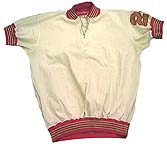
Condors 1971-72
Home Warmup |
CONDORS YEAR-TO-YEAR RESULTS
1970-71 Season
Record: 36-48 (Fifth Place in Eastern Division)
Missed Playoffs
1971-72 Season
Record: 25-59 (Sixth Place in Eastern Division)
Missed Playoffs
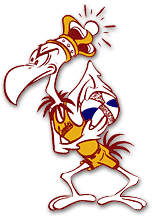
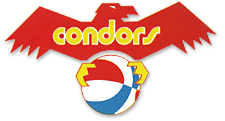
 Exterior 1 | Exterior 2
Exterior 1 | Exterior 2 1970-71: Jack McMahon
1970-71: Jack McMahon 1971-72: Jack McMahon & Mark Binstein
1971-72: Jack McMahon & Mark Binstein

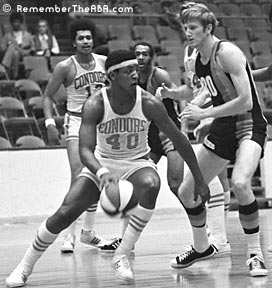
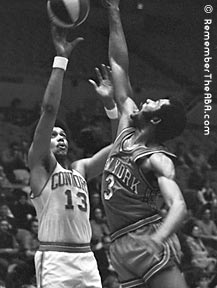
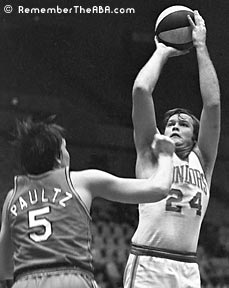




 After a 4-6 regular season start (not bad by Condors standards!), GM Binstein suddenly canned coach Jack McMahon. Then, in a move that further surprised many ABA observers, Binstein named himself as McMahon's replacement. Binstein had no previous pro coaching experience, although he had played some college basketball at West Point.
After a 4-6 regular season start (not bad by Condors standards!), GM Binstein suddenly canned coach Jack McMahon. Then, in a move that further surprised many ABA observers, Binstein named himself as McMahon's replacement. Binstein had no previous pro coaching experience, although he had played some college basketball at West Point. 